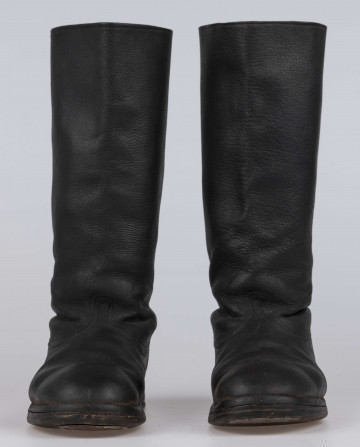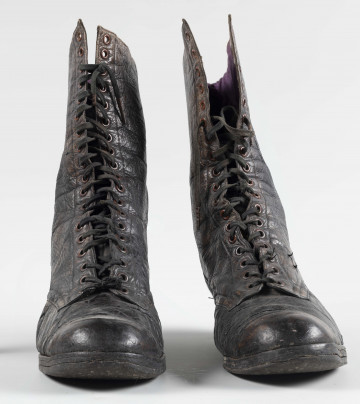
Men’s shoes with uppers
1910 — 1930
National Museum in Lublin
Part of the collection: Folk craft of the Lublin Region (19th/20th c.)
High leather shoes were worn with the festive costumes worn by men and women. They come from the inter-war period and were acquired for the museum from the village of Niemirówek Kolonia near Zamość. The upper part of the shoe was made of three parts – the heel (‘luba’), the calfskin upper and the vamp. Uppers usually reached above the knee (height 37 cm). Shoes were sewn on the left side, then turned to the right side and a hoof was inserted into the middle, where it was shaped. Finally, the heel was attached to the shoe and a metal shoe adapted to its shape was nailed on. Both shoes were identical and only adapted to the left and right foot after a long period of walking. They were also generously sized, so that a foot wrapped in ‘onuca’ could be put into them, and during severe frost they could be filled with specially twisted straw. In order to protect them from getting wet from the outside, they were usually coated with tar or soot and fat to give them a dark colour. They were very sturdy and they served them for many years because their owners saved them for special occasions, wearing them only for important events and festive outfits.
This type of shoe was made by shoemakers in Tyszowce, located near Tomaszów Lubelski, hence its name. There were many shoemakers in the town almost from its inception, and the first guild was set up in the Middle Ages. Only Christians were allowed to make Tyszowce shoes. They were willingly bought by the inhabitants of the south-eastern part of the Lublin region and the northern part of Podkarpacie directly from the shoemakers in the town or in the nearby markets. The production of these shoes ceased at the beginning of the second half of the 20th century because there was no longer demand for them.
Author / creator
Dimensions
cały obiekt: height: 41 cm
Object type
footwear
Technique
cobbler techniques
Material
natural leather
Creation time / dating
Creation / finding place
Owner
The National Museum in Lublin
Identification number
Location / status

1910 — 1930
National Museum in Lublin

1935 — 1940
National Museum in Lublin

1918 — 1939
National Museum in Lublin
DISCOVER this TOPIC
National Museum in Lublin
DISCOVER this PATH
Educational path